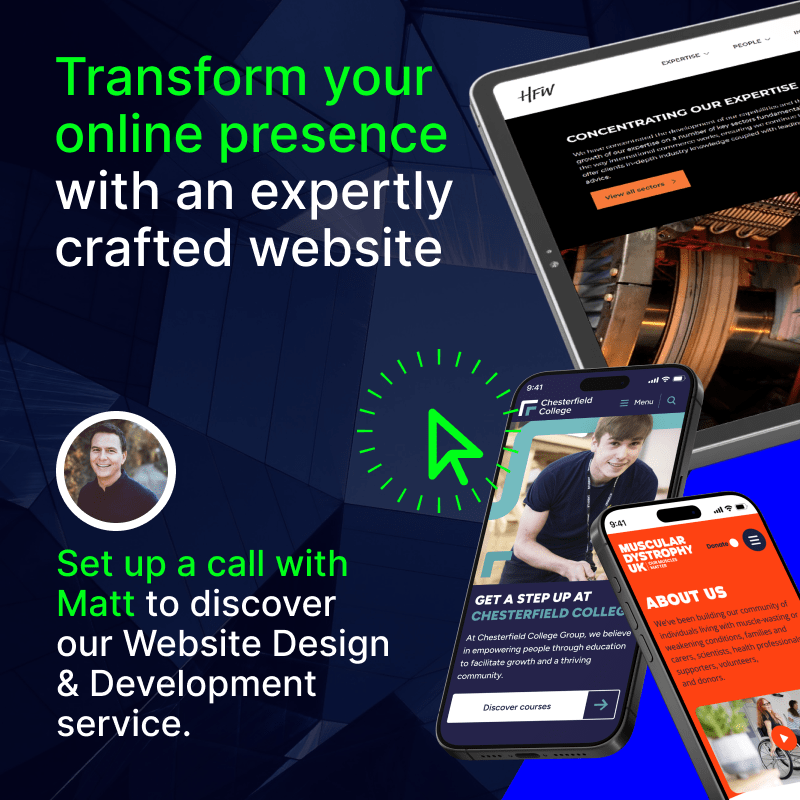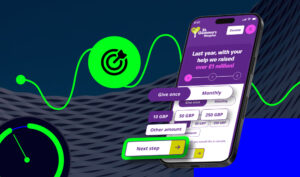How to Improve Conversions on Your Charity Donation Page
If your charity’s donation page isn’t converting well, you’re missing out on vital funds. One thing many organisations overlook is the importance of optimising donation pages for conversions over traffic.
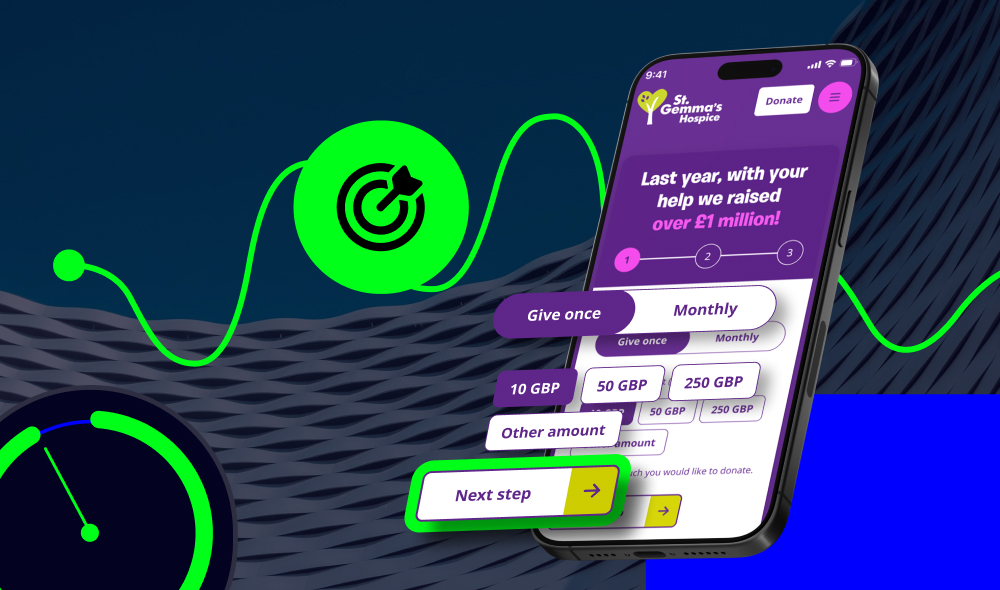
Mark Perry is a Digital Project Manager at Itineris, dedicated to fostering strong client relationships and driving success through innovative digital solutions. With a focus on clear communication and collaboration, he ensures every project aligns with client goals, delivering exceptional results and creating long-term value for all stakeholders.
Even if you have a large and ready-to-donate audience, it won’t be of much use if they have a hard time navigating your donation journey. And even if your cause is clear and convincing, a few small tweaks on your charity donation page can make an enormous difference to your fundraising efforts.
The fact that only 22% of companies are happy with their conversion rates shows that there’s always room for improvement.
So, how do you make the most of your audience and the traffic your charity website generates? We’ll break down some of the key strategies in the guide below.
Measuring and Optimising Your Fundraising Conversion Rate
Before streamlining your donation process, you need to understand your fundraising conversion rate and how to measure it.
Keeping a close eye on your conversion rate will help you raise more money without increasing your traffic. It will also help you identify what changes need to be made, and which areas of the fundraising journey your users are getting stuck on.
By tracking and optimising conversions, you can refine your donor journey, remove obstacles and encourage more people to complete their donations. It’s an iterative process, but this just means your charity or non-profit will continue to see enhanced results when you take your fundraising conversion rate seriously.
Understanding Your Conversion Rate
Your conversion rate is the percentage of visitors to your donation page who complete a donation. This metric helps you understand how effective your page is at turning interest into action.
To calculate it, use this formula:
(Number of donations ÷ Total visitors) × 100 = Conversion rate (%)
For example, if 300 people visit your donation page and 45 make a donation, your conversion rate is 15%.
A strong conversion rate varies depending on factors like audience type, traffic sources and donation page design.
Studies show that charity donation pages typically convert at around 16 – 20%, but this can fluctuate. What matters most is improving your own baseline over time.
Why You Need to Measure Fundraising Conversions
Tracking your conversion rate allows you to pinpoint what’s working and what’s not. It’s an essential metric, as it directly relates to how successful your fundraising efforts are.
You could be generating a load of traffic to your charity website or donation pages, but if that traffic isn’t converting, then it’s pointless.
This becomes even more valuable when you invest in paid advertising. While you might be driving traffic and generating awareness, a low conversion rate means ad budget is being wasted,
If your rate is low, visitors may be encountering friction – such as a complicated form, unclear messaging or a lack of trust signals. Or maybe they just aren’t seeing the value in your offering.
Ultimately, if your donation conversion rate isn’t hitting the mark, then every other metric (like traffic) is purely a vanity number. What matters is that the people engaging with your charity and landing on your donation page end up supporting you. If not, your website and digital presence isn’t doing its job.
Consistently monitoring and improving your conversion rate ensures you’re maximising every fundraising opportunity, making your digital strategy more effective and cost-efficient.
First, Design Your Donor Journey With Your Audience in Mind
There are many different factors that go into conversion rate optimisation. It involves practically every detail and element on your website, as well as the various other aspects and experiences that form your entire digital presence.
However, before we get into all of these ‘finer details’, there’s one thing that matters most – design your donor journey (and your entire online presence) with your target audience in mind.
What do we mean by this? Well, your audience isn’t just anyone – they’re people who care about your cause, have specific motivations for giving and want to feel connected to the impact of their donation.
Understanding these motivations is the key to designing a donor journey that removes friction and inspires action.
For example, a first-time donor needs different reassurance than a repeat supporter. Someone arriving from a social media ad might require more context than a visitor who’s already familiar with your work.
The more tailored your approach, the more likely visitors will feel compelled to give.
Think about what drives your supporters. Are they motivated by personal stories? Do they want to see tangible outcomes from their donation? Do they respond best to urgency, community involvement or exclusive experiences?
Your donation page should reflect these motivations and make donors feel like their contribution matters.
This could be as simple as showing them the immediate impact of different donation amounts – such as how £20 provides a meal for a homeless family – or recognising their generosity with an instant thank-you message, a donor wall or a progress tracker showing how their gift contributes to a larger goal.
Ultimately, your donor journey should be seamless, rewarding, and built around what your audience needs to take that final step. If you design with this in mind, you won’t just improve your conversion rate – you’ll create stronger, more lasting relationships with your supporters.
11 Fundraining Conversion Rate Optimisation Best Practices
While each charity website and audience is different, here are some of the core principles and tactics to help optimise your donor experience.
Put User Experience at the Heart of Your Design
A frictionless, engaging experience is crucial to turning website visitors into donors.
Your donation page isn’t just a transaction point – it’s an opportunity to make supporters feel emotionally connected to your cause.
Start by designing with clarity and simplicity. Your page should be easy to navigate, visually compelling and mobile-friendly. Use strong, emotive imagery, impact-driven storytelling and clear messaging that reinforces the urgency and significance of each donation.
Reduce cognitive load by avoiding unnecessary distractions. A clean layout, intuitive form fields and clear steps will keep users focused on completing their donation.
Most importantly, make it easy for donors to see the impact of their gift. Whether it’s through dynamic progress bars, testimonials or personalised thank-you messages, reinforcing their role in your mission builds trust and encourages repeat giving.
Remember, donations aren’t about your charity receiving money, they’re about your audience making an impact. So, frame your pages to put your audience first (both via their experience and your page content), and you should see more positive results.
Streamline the Donation Process
Every extra step in the donation journey increases the chance of drop-off. A high-converting donation page is one that minimises friction and maximises ease.
Quite simply, the easier it is to donate, the more donations you can expect to receive. Here are some key ways to streamline the process and cut down unnecessary steps:
- Limit form fields – Ask for only the essential information. The more fields a donor must fill out, the higher the likelihood they abandon the process.
- Enable quick donation options – Pre-set donation amounts with clear impact statements help donors make decisions faster. Consider adding a ‘one-click’ repeat donation option for returning supporters.
- Remove unnecessary steps – Do donors need to create an account? If not, don’t require it. Let them give first, and then invite them to stay engaged.
Speed and simplicity should be your top priorities. The fewer obstacles in the way, the higher your conversion rates will be.
Strong Calls to Action
No matter how much great content or social proof you have on your page, your call to action (CTA) is ultimately what drives donors to take that final step. So it needs to be clear, compelling and persuasive.
An effective CTA should:
- Be action-oriented – Use strong verbs like ‘Give Now’, ‘Make an Impact’, or ‘Change a Life Today’ to create urgency.
- Be specific – Instead of a vague ‘Support Us’, try ‘Donate £25 to Feed a Family for a Week.’
- Stand out visually – Ensure your CTA button is bold, high-contrast, and placed prominently on the page.
- Reinforce the emotional connection – Tie your CTA to the donor’s impact. ‘Join the Fight Against Homelessness’ is more motivating than ‘Submit Your Donation’.
Test different CTA placements, wording and button designs to see what resonates most with your audience. It may seem like a minor detail, but even small tweaks can lead to significant improvements in conversion rates.
Test Continually
Optimising fundraising conversions is never a one-time task. It’s an ongoing process of testing, learning and refining. So, you need to ensure you keep monitoring and improving the way your pages work.
Importantly, there’s no cut and paste solution to conversion optimisation. Instead, your page requires tailored solutions, depending on your audience and data insights.
This is where steady A/B testing comes into play.
Use A/B testing to experiment with different elements, such as:
- Headline messaging and impact statements
- Images, videos and page layouts
- Donation amount presets and descriptions
- CTA text, button size and colour
- Page length and form placement.
Track key metrics like donation completion rates, drop-off points and average gift sizes. Small changes, such as reordering form fields or adjusting your CTA language, can have a big impact on performance.
Although, these are often tests done somewhat at random. To gain even more meaningful insights about your donation page performance, you could use heatmaps to track user engagement.
This allows you to see exactly which parts of your page are working and which aren’t, helping you refine the entire user experience.
By continually testing and optimising, you’ll ensure your donation page evolves based on real user behaviour, leading to higher conversions and more long-term supporters. This is a critical task, as basing conversion optimisation on guesswork will get you nowhere.
Provide Enough Content
One of the most overlooked aspects of fundraising conversion rate optimisation is ensuring that potential donors have all the information they need before making a decision.
If they have lingering questions about how their donation will be used, whether their payment is secure or what impact their contribution will have, they might hesitate – or worse, abandon the process entirely.
First, make sure you answer supporters’ questions upfront.
Donors shouldn’t have to dig through your site to find essential details. Anticipate their concerns and provide clear, concise answers in the right places. Some common areas to address could include:
- Where does the money go? – Be transparent about how funds are allocated. A breakdown of where donations are spent (e.g., direct impact vs. administrative costs) builds trust.
- Is my donation secure? – Reassure donors with information on payment security and encryption. Mention if you use a trusted payment processor.
- Why donate now? – Explain the urgency of your campaign and what their donation will achieve.
- Can I donate in other ways? – Provide details on recurring gifts, corporate matching or peer-to-peer fundraising options.
You can answer these questions across different sections of your site:
- Homepage – Clearly highlight your mission and impact.
- Campaign pages – Provide specifics on how donations will be used.
- FAQs – Address common questions in one easy-to-find location.
- About page – Share a deeper story about your organisation’s history, mission and values.
- Blog posts – Cover timely topics, such as the importance of giving during certain seasons or behind-the-scenes updates on how donations are making a difference.
Again, make this content about the donor, not your charity. Make them aware of the positive impact they’re creating, and help them understand why they should make a donation, not why you should receive one.
By proactively addressing donor concerns, you reduce friction in the decision-making process and create a sense of trust and confidence – both of which are key drivers of conversion.
It’s also worthwhile to invest in content marketing efforts. Inbound marketing increases conversion rates by 6% – 12% for the average website. So, sharing useful content can play a major role in improving charity donations.
Optimise for Mobile
This is an obvious one, yet it’s something that many conversion-focused pages overlook.
With more than half of donations coming through mobile devices, ensuring a seamless mobile experience is essential. A donation page that’s difficult to navigate on a smartphone will cause frustration and lead to abandoned contributions.
And if you consider that more than half of donations do come through mobile devices, imagine how many potential donors you lose from a poor mobile experience.
Your donation page should automatically adjust to different screen sizes, making it easy to read, navigate and complete transactions on any device. If you’re using a platform that doesn’t handle this natively, consider switching to one that does.
Slow-loading pages kill conversions. Optimise images, limit heavy scripts and use caching to ensure donors don’t lose patience before they reach the payment step.
Typing on a mobile device can be tedious, so minimise the number of fields required. Autofill options, pre-selected donation amounts and one-click payment options (like Apple Pay and Google Pay) will make the process smoother.
Again, it’s all about removing barriers to giving and making it easier for supporters to act on their generosity, no matter where they are. And mobile optimisation isn’t only about making your site work well on smaller screens – it’s also about speed, accessibility and ease of use.
Make the Donor Journey Accessible
Speaking of accessibility, it’s a crucial aspect of any functioning website.
Ensuring your donation journey is accessible is not just a legal requirement – it’s fundamental to creating a seamless and inclusive experience for all supporters.
With one in five people in the UK living with a disability, inaccessible digital platforms risk alienating a significant portion of potential donors. Accessibility barriers such as poor colour contrast, lack of keyboard navigation and unreadable text can frustrate users and lead them to abandon the donation process altogether.
A well-designed, accessible website benefits everyone.
Features like clear navigation, structured content and compatibility with assistive technologies improve usability for all visitors – not just those with disabilities.
Studies show that accessible websites often see better engagement and higher conversion rates, making accessibility a strategic advantage as well as an ethical obligation.
With evolving legislation and increasing user expectations, organisations must act now to future-proof their digital platforms.
By prioritising accessibility in your donation journey, you ensure that every potential donor, regardless of ability, can support your cause with ease.
Provide Multiple Payment Options
A major factor in increasing conversion rates is ensuring donors can give in the way that’s most convenient for them.
The fewer obstacles in their way, the higher the likelihood of completing a donation.
At a minimum, accept all major credit and debit cards. However, to cater to different preferences, consider adding PayPal, Apple Pay and Google Pay (ideal for mobile users who want a one-click checkout), and direct debit and bank transfers (useful for major gifts and recurring donations. Some charities even accept cryptocurrency and digital wallets.
Ultimately, the more options you open up, the more opportunities you’ll create.
Something else to consider is simplifying recurring giving.
Encouraging monthly donations increases donor lifetime value. So, you could make recurring giving the default selection on your donation form, with clear messaging on the impact of sustained support.

Ensure Your Donation Page is Easy to Find
Easy navigation is the cornerstone of any user-friendly website. But when it comes to charity websites where your donation page is your core goal, you need every page on your site to point to the donation page.
Even the best-designed donation page won’t help if people struggle to locate it. Your job is to ensure that no visitor leaves your site wondering, ‘How do I donate?’
To start, your donation page should be prominently linked:
- In your website’s main navigation bar.
- As a fixed button on every page (e.g., a sticky ‘Donate Now’ button).
- On high-traffic pages, such as blog posts, impact stories, and campaign pages.
- Embedded directly within key pages to minimise clicks.
And that’s only on your website. You’ll also want your donation page to be a central part of your other digital channels and areas of strategy.
For this, make sure your donation page is included in:
- Your social media bios and posts.
- Email signatures of your team and volunteers.
- Regular newsletters and fundraising appeals.
Basically, any place that you’re attracting and engaging an audience is an opportunity to drive that traffic to an optimised donation page.
In doing this, it’s important to monitor where your donations are coming from and which pages drive the most conversions. If a high-traffic page has low conversion rates, tweak the design, messaging or CTA placement.
A well-placed donation page ensures potential supporters don’t miss the opportunity to contribute when they feel inspired to do so.
Re-Engage Your Past Donors
It’s easier to encourage someone to give again than to convince a first-time donor. Retaining and re-engaging past supporters should be a core part of your fundraising strategy.
There are a few key ways to do this. One is to use donor data to personalise communications. Address them by name, acknowledge their past support and highlight the impact their previous gift made.
You’ll also want to send engaging email campaigns to past donors to gather repeat support. Regularly update past donors with:
- Impact stories showing how their contribution made a difference.
- Invitations to exclusive donor appreciation events.
- Limited-time matching campaigns to incentivise another donation.
If a donor previously gave £25, suggest £30 this time. Showing incremental impact (e.g., ‘£5 more provides school supplies for an extra child’) can be highly effective.
Prompt past donors to turn their one-time contribution into a monthly commitment, reinforcing how ongoing support leads to sustained impact.
Of course, a major thing to be aware of is that you’re not pushy. But, by pushing the right communication and making repeat donations easy and appealing, you can build a sustainable donor base that contributes regularly to your cause.
Continually Refine the Process
Conversion optimisation is a marathon, not a sprint
This means optimising the donor journey is never a one-time task – it’s an ongoing process of refinement, testing and enhancement. After all, your conversion optimisation efforts are only going to make a difference if they’re based on real user insights, and not just guesswork.
As user behaviours evolve and technology advances, charities must stay agile, using real-world data and insights to fine-tune the experience.
Every interaction on your website provides valuable information about how donors engage, where they hesitate and what encourages them to complete a donation.
Regular analysis of these behaviours allows for strategic improvements, from adjusting messaging and simplifying forms to streamlining payment options. Small, data-driven tweaks can significantly improve conversion rates over time.
A commitment to continuous optimisation ensures that your donor journey remains seamless, accessible and effective. So, by treating conversion optimisation with a long-term mindset, you create a digital experience that evolves with your audience – maximising engagement and long-term support for your cause.
Even if your charity website exceeds the 20% conversion rate benchmark your sector may have, this still doesn;t mean you can;t improve. As long as users leave your site without making a donation, there’s always room to do better. So, take the long-term approach and tweak and optimise your site at every opportunity.
Examples of Streamlining Charity Donation Processes
We’ve covered some of the main things to focus on if you want to streamline and improve your donation journey. However, as we’ve said, the most important thing to do is tailor your donation optimisation to your audience. This requires a custom approach backed by data insights.
That in mind, here are some of the charities we’ve worked with over the years, and some of the strategies we’ve used to optimise and improve their donation journeys.
Shooting Star Children’s Hospices
Shooting Star Children’s Hospices needed to modernise their digital fundraising approach, particularly for their annual Christmas campaign. Itineris developed a multi-channel strategy to streamline the donor journey, making it easier for supporters to engage and donate.
By optimising landing pages and refining audience targeting across digital channels, we helped them more than double their initial fundraising goal. The campaign also drove a 16% increase in landing page conversions and secured a solid group of new regular donors, ensuring long-term sustainability.
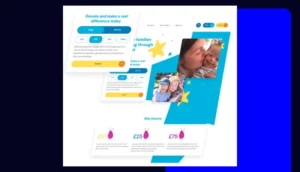
Forget Me Not Children’s Hospice
Forget Me Not Children’s Hospice needed a complete digital transformation to improve engagement, increase donations and support their long-term growth.
Our team redesigned their website with an intuitive user experience, optimised SEO, and high-performance landing pages to streamline the donor journey. The result was an 84% increase in organic traffic, a 22% rise in website income and a significantly improved digital experience that continues to drive fundraising success.
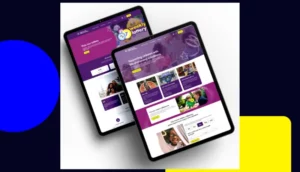
East Anglia Children’s Hospices
East Anglia Children’s Hospices (EACH) needed to transform their brand identity to create a more positive, engaging presence that would inspire support and increase donations.
Our team developed a bold, uplifting brand strategy and ensured consistency across all digital and physical touchpoints, including their website and donation platforms. With an 18% increase in donations, a 26% rise in event registrations and a stronger emotional connection with their audience, our efforts made a clear impact.
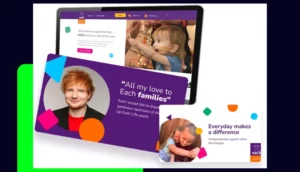
Muscular Dystrophy UK
Muscular Dystrophy UK (MDUK) needed a modern, accessible platform to enhance fundraising, community engagement, and information sharing.
Our team developed a flexible WordPress site that prioritised usability, accessibility, and performance, ensuring a seamless donor journey. The results were transformative, with a 125% increase in donation conversion rates, a 39% rise in organic traffic, and a significantly improved user experience.
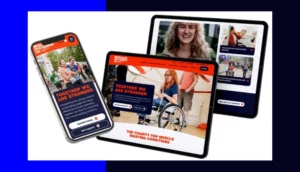
Motor Neurone Disease Association
The Motor Neurone Disease Association (MNDA) needed a more effective digital platform to enhance donor engagement and event participation.
To achieve this, we redesigned their website with a streamlined donation process, intuitive navigation, and optimised event sign-ups.
This helped achieve a 44% increase in event registrations, a 21% rise in website income, and a more seamless experience for supporters.
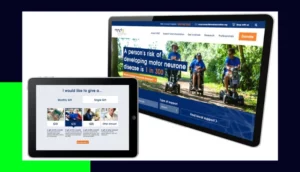
Make the Most of Your Charity Donation Page
Building a beautiful charity website and generating traffic is, of course, incredibly important. But, if that traffic isn’t converting on your most important page (your donation page), then you need to make some changes.
As a charity, you should look at donation page conversions as an ongoing process. Continually measure your conversion rate, test conversion details and apply new tactics to constantly improve things. By taking a consistent, iterative approach to improving conversions, you could see a major upswing in the donations you receive each year.
At Itineris, we’ve helped many major charities improve their donation journeys and surpass donation goals through strategic digital enhancements. Get in touch with our team to see how we can help your organisation.

